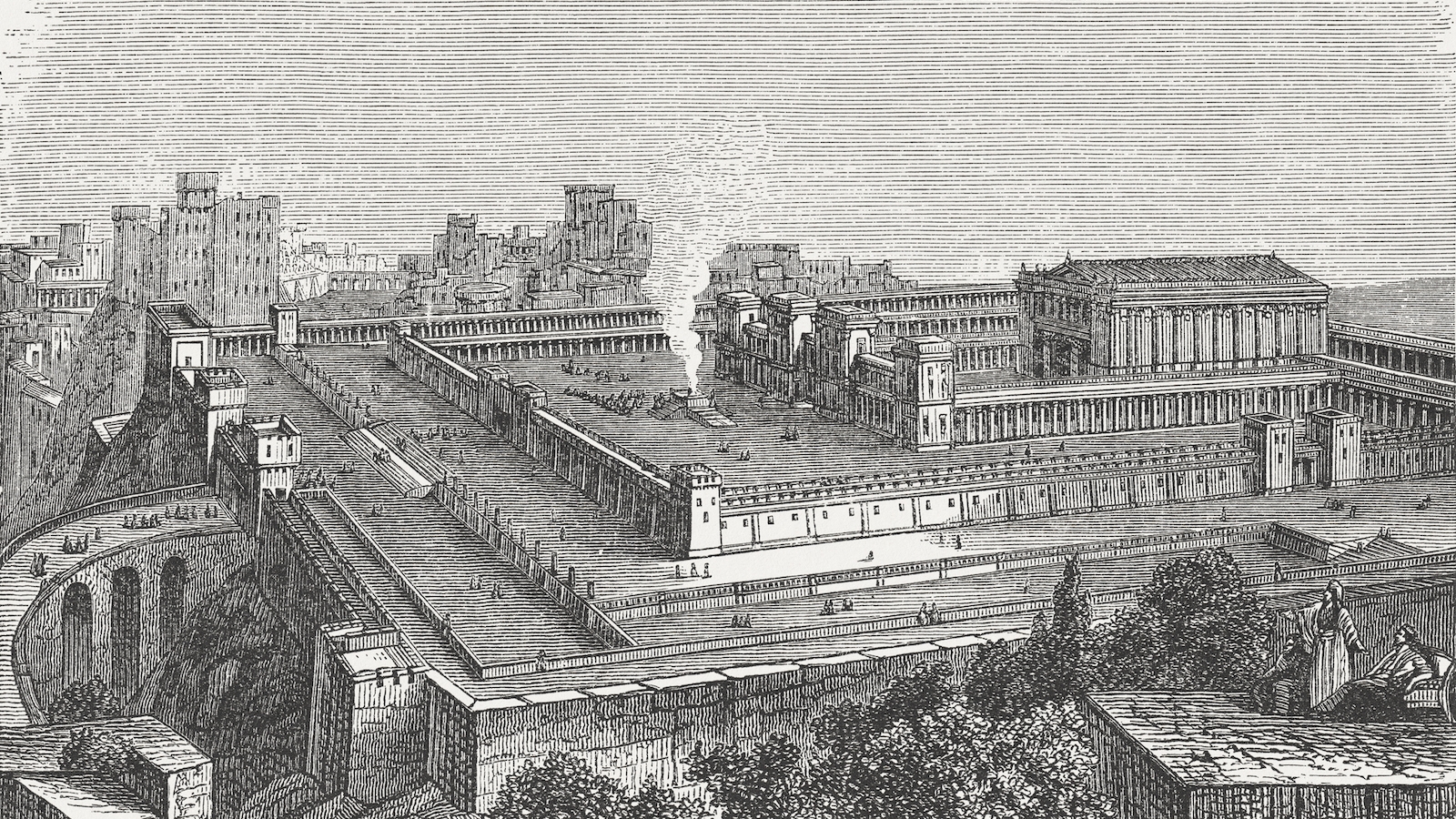Commentary on Parashat Terumah, Exodus 25:1-27:19; Numbers 28:9-15; Exodus 30:11-16
If the sudden shift of gears in the from the heroic narratives of Genesis and Exodus to the apparently pedantic legalism of Mishpatim (‘Laws’) is puzzling, this week’s Torah portion is even more problematic. In Terumah (which means ‘Donation,’ referring to the materials donated by the Israelites for the construction of the Tabernacle), we move from the legalistic concerns of last week’s portion to the ritualistic details of the building and maintenance of the Tabernacle.
Discussing the Temple
We begin a very long discussion, which actually takes us through much of the rest of the Torah, of the Temple: the materials needed to construct it, its design, its vessels, the sacrifices to be offered and the rites to be practiced within it. If the legal material of Mishpatim does in fact hold a good deal of relevance for our own lives, and actually represents a shift from the stories of redemption to the commandment to redeem, what does the Temple and its rituals mean to us?
The Temple ritual is just that–ritual. It has no ‘real’ effect on the ‘real’ world, and does not change it, in the way that freeing a slave, or being charitable to the needy, does. If following the moral-ethical precepts of the Torah makes me an actor, and a playwright, rather than a member of the audience, in God’s drama, what does the ritual of the Temple do?
What do these symbolic acts mean for the people who worshipped in the Tabernacle in the desert, or in the Temple in Jerusalem? What were the sacrifices, the burnt offerings, the various rituals meant to do for them? What meaning did they have in their lives? And, by extension, what difference could they possibly make in ours?

Help us keep Jewish knowledge accessible to millions of people around the world.
Your donation to My Jewish Learning fuels endless journeys of Jewish discovery. With your help, My Jewish Learning can continue to provide nonstop opportunities for learning, connection and growth.
To get to an understanding of where ritual fits in to the Torah’s narrative, I would like to share with you the approach of Rabbi Moshe ben Nahman (known as the Ramban, or Nahmanides) to the Temple. At the start of his commentary on Terumah, the Ramban posits that the Temple was meant to be a reenactment of the dramatic experience the Jewish people had just gone through; the giving of the Torah on Mount Sinai.
That moment, when the entire nation experienced directly the presence of God, and heard His word, was the supreme moment of Jewish, and in fact of human, history. Almost immediately afterwards, is instructed to tell the Jews to construct a Tabernacle, to be used while they are in the desert, which foreshadows the permanent Temple which will be built when they arrive in Israel.
Nahmanides posits that the point of the Temple, its raison d’etre, is NOT the offering of sacrifices or the reciting of prayers. Rather, he says, it is a direct continuation of the Exodus narrative:
The secret of the Tabernacle is that the Divine Glory, which rested on Mount Sinai, rests upon it [the Tabernacle], in a hidden way. And just as it says there [on Mount Sinai] ‘and the Glory of God rested on Mount Sinai’ (Exodus, 24, 16), and it says ‘behold, the Lord our God has shown us his glory and his greatness’ (Deuteronomy, 5, 20), so, too, it says concerning the Tabernacle ‘and the glory of God filled the Tabernacle’ (Exodus, 40, 34). …And there was in the Tabernacle, always, with Israel, the glory which was seen by them on Mount Sinai.
Reliving Revelation
According to the Ramban, the Tabernacle, and, after it, the Temple in Jerusalem, was meant to offer the people the opportunity to experience, again and again, the defining moment of Jewish history; the revelation at Sinai. This was achieved through ritual; the physical experience of the Sanctuary, the vessels, the Priests, the Levites, the sacrifices, all came together to create for the devotee the ‘ultimate’ experience, the experience of Sinai, the presence of God. These ritual objects and acts are the means, not the ends, with which one could relive the most important moment in our collective consciousness.
I think that there is something important being said here about a gap, a fissure in our lives. A gap between what once was, or might have been, and what is. Between a remembered, imagined, or anticipated reality, and life as it is really lived. The Jewish people at Mount Sinai went thorough a heroic, unforgettable, transcendent experience, the climax of a series of such experiences. By definition, whatever came next would be anti-climactic.
The Torah, after the ‘heroic’ period of Genesis and Exodus, now moves on to grapple with a question that we must all deal with in our own lives: how can one live a life without transcendence, without heroism, without the fantastic events which only rarely befall a nation, or an individual? There is a gap, a dissonance, in our lives; between life as we may, at some heroic moment, have lived it, or as it may have been lived in some distant heroic past, or in some half-imagined future, and life as we actually experience it on a day to day basis–taking out the garbage, fighting with our parents, fighting with our kids, studying for tests, changing diapers, going to the bank, paying bills.
Very few human beings live lives of intensely heroic activity. And yet, we long for a life that is heroic, transcendent, full of ultimate meaning. We want such a life, we need such experiences.
In the laws of Parashat Mishpatim we close this gap, we harmonize this dissonance. The Torah gives us the opportunity to recreate, through our own actions, some of the heroic events of Exodus. If God redeemed us in Egypt, Jewish law challenges us to be redeemers, and shows us how to be that. If God lifted up the downtrodden Jewish slaves, the Jewish laws of charity demand of us that we approximate God’s behavior, and show us how to do that. We are commanded to evolve from readers of someone else’s story, into actors, heroes, in a real-life drama, in which we can, again and again, on a day-to-day basis, experience the dramatic narrative of exile and redemption, by acting upon the moral-ethical principles of Mishpatim.
The Way of Ritual
Parashat Terumah, on the other hand, gives us another way, a very different way, to make our lives heroic–the way of ritual. If the Israelites experienced at first-hand the drama of redemption from Egypt, the splitting of the Red Sea, and the receiving of the Torah at Mount Sinai, we can also, through ritual, break through the less-than-heroic nature of our every day lives and experience these events for ourselves. The Temple ritual is the way to experience God the way the Israelites did at Mount Sinai. If we successfully give ourselves over to the strategy of the ritual, if we allow it to work for us, we can have that experience as well.
On Passover, at the seder, one can transform oneself into someone who was himself or herself redeemed from Egypt. On Purim, with the reading of the megillah (Scroll of Esther) and the rituals of celebration, we can transcend our reality and in some way share the experience of the Jews of Persia, who actually lived through the terrible danger, and the miraculous salvation. Every Shabbat, the Rabbis tell us, we can, through ritualized rest, acts of prayer, song, Torah study, and feasting, experience something of the end of days, the Messianic era–ma’ayn olam ha’ba, a bit of the world to come–and transcend the travails of this world.
These, and other, rituals offer us the chance to live a heroic moment, fashioned out of what would otherwise be the dry stuff of history. It is through ritual that we can create existences and experiences not otherwise accessible to us, but for which the soul yearns.
The question that occurs to me now is this: Can we discern, in the Jewish world in which we live, two types, two strategies for achieving transcendence within the mundane: one which, through acts of morality, redemption, justice and charity, seeks to imitate and recreate the miraculous works of God in the book of Exodus, and another, which seeks to introduce the transcendent, the miraculous, the heroic, into our lives through acts of ritual?
And is not the Torah, by placing the laws of Mishpatim and then the rituals of Terumah immediately after God’s miracles in Exodus, telling us that both paths are there for us to take?
This D’var Torah is dedicated to the memory of Tani Goodman, who lived life heroically.
Provided by the Bronfman Youth Fellowships in Israel, a summer seminar in Israel that aims to create a multi-denominational cadre of young Jewish leaders.



